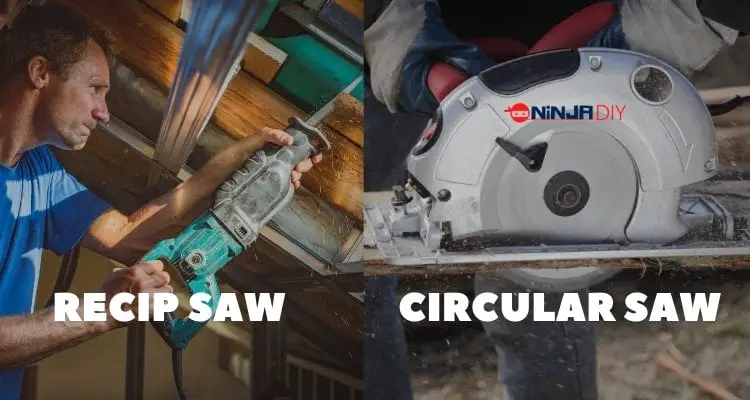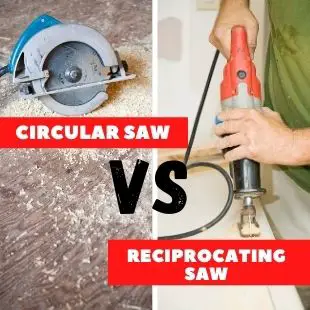Although circular saws and reciprocating saws are similar, in that they are both power saws, they are also in many ways quite different.
The primary difference is their shape, as one saw is hand-held and has a toothed knife-shaped blade (the reciprocating saw), while the other is normally secured to a work bench and has a toothed disc-shaped blade (the circular saw).

Circular saws and reciprocating saws also specialize in certain things; the circular saw is ideal for carpentry, whereas the reciprocating saw is designed for demolition and construction.
Both are great for DIY. So, how else are circular saws and reciprocating saws different?
What’s a Power Saw?
First off, what is a power saw? These are electric saws that are designed to make the handyman’s (or handy woman’s) life easier.
They’re powerful and efficient, with serrated blades specifically designed to cut right through wood, metal, drywall, plaster, PVC, etc. Some are even capable of tackling brick and cement.
As you can probably imagine, they can be a real game-changer.
Power saws are used for demolition, construction, carpentry, and a whole host of other DIY. They come in a variety of blade shapes and are made of either carbon steel, high-speed steel, carbide grit, or a combination of carbon and high-speed steel (referred to as bi-metal).
What’s a Circular Saw?
The circular saw, as its name implies, has a circular blade, which is angled vertically. It is electric and spins rapidly, carving through wood like butter.
For those who are already properly experienced with power tools, they are perfect for DIY.
These blades have your classic, saw-toothed edges. Circular Saws are crafted primarily from steel.
The body of the blade is made of carbon steel, while the serrated tip is made of an even harder high-speed steel material. The teeth (serrated edges) may vary in shape somewhat.
Circular saws can cut not only through woods, but also fiberglass, slate, plastic, and even metals, brick, cement, etc.
They are used to make exceptionally clean, straight cuts for various construction and DIY projects.
What’s a Reciprocating Saw?
A reciprocating saw is a handle-held saw with a small, knife-like, serrated blade. This is moves back and forth rapidly while the user holds it.
Reciprocating saws can be used to carve through not just wood, but also stucco, plaster, masonry, certain types of metal, drywall, etc.
Reciprocating saws are made of a few different types of steel, which are carbon steel, high-speed steel, carbide grit, or they are bi-metal (contain multiple types of metal).
Bi-metal reciprocating saws are recommended the most highly, as they possess carbon steel bodies and high-speed steel teeth, for optimum flexibility and durability.
Reciprocating saws are mainly used for demolition and remodeling and are excellent for general DIY, where straight lines are not necessarily required.
What’s the Difference Between a Circular Saw and a Reciprocating Saw?
When it comes down to it, circular saws and power saws are really very different. The main similarities are that they both cut, and they’re both typically made of some manner of steel. The shape, price, and cut all vastly different.
See for yourself.
Function
While reciprocating saws move back and forth rapidly, circular saws spin in place. This makes controlling them a bit easier, but they’re also less portable. It’s a trade-off.
Design
Circular saws and reciprocating saws have very differently shaped blades, with reciprocating saws being shaped like an industrial electric meat carver.
Circular saws, on the other hand, are comprised of a single, large disc.
Additionally, reciprocating saws are hand-held, whereas circular saws remain stationary as you place the wood beneath to be cut.
Cost
There is a marked difference between circular saws and reciprocating saws when it comes to the price tag.
Circular saws are heavy-duty and often come with blade-guards and even lights. They do all of the work for you, leaving the task to a super-powered, rapidly rotating disc.
So, it stands to reason that they’d cost between $100-$300. They are also considered to be more precise and to deliver higher-quality cuts in general.
Reciprocating saws, on the other hand, have a simpler design; they are simply comprised of a handle and blade. This means that they are considerably more affordable, at as little as $50-$150.
Type of Cut
Reciprocating saws cut fast, quite a bit faster than circular saws. The cut is rougher, as a trade-off. For this reason, reciprocating saws are usually used for construction and other gritty work.
Circular saws cut more slowly, with the wood (or other material) being slowly fed through. As a result, the cut is incredibly fine, making circular saws ideal for woodworking and other fine, artistic work.
In summation, both saws can be used for the same tasks, but each will achieve certain things a bit better!
Which Saw is Best?
Which saw is best depends on your level of experience, and what exactly you’ll be using it for. As touched on above, circular saws are ideal for carpentry.
They make flawless cuts that can be seamlessly placed together. They are even more powerful than reciprocating saws, as they can cut through cement.
While reciprocating saws are very heavy-duty themselves and can cut right through nails, they are limited when it comes to harder materials. They’re best suited for wood, metal, PVC, and drywall.
Circular saws tend to be more user-friendly, as they are easier to control. This can make them more suitable for a beginner.
So, what do you need a saw for, demolition and construction, or woodworking and DIY? Do you need a saw that’s portable and hand-held, like the reciprocating saw? Or a stationary, heavy-duty circular saw?
There’s your answer!
Summary
So, as you can see, despite their few similarities, circular saws and reciprocating saws are quite different.
They are each specially designed for a certain task, whether it be dirty work, like construction, or more work that requires more refinement, like carpentry.
Both saws are super-powerful and made of stainless steel, and can cut through almost any material.
So, which would you choose?
Ninja Team Members Working On This Page

Adrian – Web Master / Construction Professional
Construction Professional, driver, crane operator, handyman … As a construction pro I love to get creative and see things done with my hands coming to life. Here I share with you some of the things I learn and hopefully you’ll get something out of it. Enjoy 🙂




